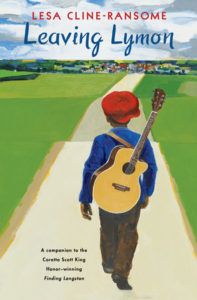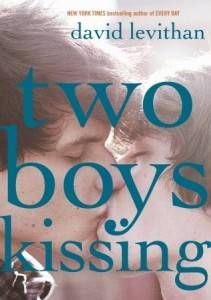What makes a bully? Are they born one? Or is there a story behind the anger? It’s 1946 and Lymon, the bully from the CSK Honor-winning companion novel Finding Langston, is being raised by his loving grandparents with whom he finds solace and hope in music. But Lymon’s world quickly dissolves. When he’s sent to live with his long-absent mother up north, he loses more than the country life he loves—he loses the version of himself that he knows. In this powerful middle grade novel, readers see a new side of the boy whose raw talent and resilience help point him in a new direction. If you’ve ever been in the position of wanting to make your library more welcoming to LGBTQ+ patrons, but had to start with absolutely nothing, hello. My name is Tirzah Price, and I have been in your shoes.
I worked in a small rural library for two years, and when I first started we had very little in the way of materials pertaining to LGBTQ+ topics and no programs or services that would attract LGBTQ+ patrons. I knew that we needed to do so much more, but despite being an actual queer woman, it was overwhelming to know how or where to start, and I often felt lost, frustrated, and unsupported. I know what it’s like to chant “Libraries are for ev-ery-one!” under your breath in training session while being told that you have to serve your unique community as an excuse to not be more inclusive. I sadly know what it’s like to win a grant to attend a national conference in the hopes of learning how to put on more inclusive programming, only to be told again and again and again that what you really need is a drag queen story hour! I think drag queen story hours are awesome, but this advice assumes that I could find a drag queen anywhere near my small town (lol forever), and more than that, it doesn’t account for the fact that other rural libraries near mine are dealing with how to politely ask parents not to bring firearms to storytime. (Because no, you cannot legally ban them from doing so!) But you want me to put on a drag queen story hour? Okay. I love librarians’ eagerness to share ideas and suggestions for what works for them, but more often than not many people assume making space for LGBTQ+ people in a library is something all staff and patrons want or will prioritize. Homophobia can exist in large and small libraries, in communities of all sizes and geographies, but it’s especially prevalent in rural or conservative areas and where access to information can be limited or just plain slow. The advice I’ve compiled here comes from my own experience and from many generous rural librarians fighting the good fight all over the country. I hope it helps you enact change, even if it’s slow to take root.
It’s Okay to Start Small
When a teen came into the library and asked me where our Pride display was, I was devastated that we didn’t have one and I wanted to overhaul our library in the space of one eight-hour shift. Not only is this physically impossible, but it’s good to build on small changes if you’re afraid of big pushback. Even incremental change is good, and hey, it’s less visible to haters! Here are some quick and easy tips:
Wear Your Pronouns on Your Name Tag
If your name tag can’t be designed to include pronouns, see if you can add them with a label maker. If you can’t do that, look for a pronoun pin to wear on your lanyard or collar. Include your pronouns in your email signature. If someone asks why you’re sharing this info, explain that you wish to normalize sharing pronouns with others and you cannot assume someone’s pronouns by simply looking at them. This shows that you care about not misgendering people and you respect the language people use about their identity. (Bonus idea: One of the most fun and successful programs I ever ran was creating pronoun pins with teens using our library’s button maker.)
Pay Attention to Your Language
Luckily, we already have a wonderful gender inclusive word in the library world to identify people who come into the library: patron. Nonetheless, I understand how in the thick of working a desk you can begin referring to people you don’t know by name as sir or ma’am, or “this gentleman waiting to check out.” In many cases, people likely identify as the gender they present with—although we should never assume. Start correcting yourself now. Instead of saying, “A woman asked for this book,” say, “A patron asked for this book.” It may seem nitpicky, but you’re going to encounter patrons whose gender identity is not binary or obvious to you, and if you’re already in the habit of using inclusive, gender-neutral language, you’re less likely to stumble over your words or misgender someone.
Don’t Assume Gender Norms When it Comes to Reader’s Advisory
It’s one of my biggest pet peeves when someone asks me for a “boy book” or a “girl book.” Books do not have gender! However, it’s an easy trap to fall into, especially when you’re dealing with parents or teachers who enforce these stereotypes. Without causing a riot, push back on what parents mean by “boy book”—do they want a sport book, or something with adventure? Pick your battles, but work to educate parents and encourage them to talk to their kids to understand what they like in a book. Gently call out gender conventions when they come up, especially during storytime.
Ask Program Participants to Share Their Pronouns
Use your judgment, but I’ve found that when putting on programs, it can be nice to add your pronouns to your introduction. Don’t make it a requirement, but if I started a program by saying, “Hi, my name is Tirzah, and my pronouns are she/her,” those who were comfortable sharing would do so. Teens are especially awesome (and sometimes eager) to share. Push through if it feels awkward, because I promise you the more you do it, the less awkward it becomes.
Dealing with Harassment or Discrimination
I don’t think fear of pushback is a good enough reason to not try something, mainly because I am relentlessly optimistic. However, it’s useful to anticipate that you will receive criticism, and think about how to deal with it when it comes. This is when having a supportive director or administrator is especially helpful because you know your community and can usually foresee potential complaints or issues. But even if you don’t have that support, here are some ways to combat pushback and harassment.
Know Your Library’s Code of Conduct and Policies
Know them well. Keep copies handy. This may seem obvious, but it’s a good rule of thumb in general. Oftentimes, homophobic reactions are counter to libraries’ general code of conduct and anti-harassment policies, so do not be afraid to cite these rules when dealing with difficult people.
Early Intervention is Key
While it’s a difficult balance to strike between eavesdropping and moderating a space, if you hear someone say something homophobic or use “that’s so gay” as a put-down, say something. You don’t have to be the shushing librarian, but you can say, “Using gay as an insult isn’t nice because there’s nothing wrong with being gay.” You don’t have to punish anyone—although if their behavior violates your library’s code of conduct, take appropriate measures. Oftentimes this will signal to people that this kind of talk isn’t allowed and they’ll act accordingly. At best, it may open up a dialogue. Which leads me to…
Take Every Opportunity to Educate
When I was throwing a Pride party at my library, our Facebook events page got a few nasty comments. Those that were straight up vulgar and hateful were hidden and deleted as they did not follow our code of conduct (which extends to our online spaces), but those that were sarcastic or critical were responded to politely and included some education and explanation about LGBTQ+ issues. A lot of people speak out of ignorance, and sometimes they just need to be informed or guided, which is all right because librarians are in the business of sharing information! One important note: If you are a straight and/or cis person, please try and do this heavy labor yourself as much as possible rather than outsourcing it to a queer colleague. It can be emotionally taxing to constantly justify your humanity to a stranger!
Dealing With Reluctant or Resistant Colleagues or Supervisors
While I was blessed with a wonderful director who was supportive, I know not everyone is so open minded. And sometimes it’s not your director, but your colleague who is the problem. Oftentimes this is more difficult than dealing with a very homophobic patron, because a library’s staff directly influences how welcoming and inclusive the library will feel to LGBTQ+ patrons. Here are some tips for dealing with difficult coworkers!
Share Anecdotes When You Can
Statistics are important, but they tell a limited story. I once worked with someone who told me they ordered a single LGBTQ+ book and put it on display, but after two months, the book had yet to circulate. Their implicit point being, “We order these books and even put them on display, but no one is checking them out, so I won’t order anymore.” To counter, I told them about the teen we both knew whom I observed came into the library three times a week and never checked anything out, but whom I often observed picked up books by David Levithan and Becky Albertalli and read them in the library for an hour or more—that demonstrated there is a need for these books!
Push for Continuing Education Opportunities
The ALA has wonderful resources, so take advantage of them. Too often, I would get caught thinking, “How is this person a librarian and yet so resistant to these ideas and the importance of providing materials for everyone?” It’s important to remember that we are all learning every day, and that not everyone who works in a library may have the same training or education that you do. Rather than give into the urge to call them a bigot (so tempting, I know!), share information. Look up certain issues and cite your sources. I’ve seen many people swayed by information.
Table a Discussion If You Have To, But Don’t Let It Drop
If you find yourself hitting a wall on a proposed change or request, say “Let’s all agree to keep thinking about this issue and do some more research.” Proposing changes during staff meetings can be stressful, especially if coworkers feel as though it’s in response to them doing something “wrong.” If it is discussed, hopefully they’ll continue to think about. Maybe they’ll come around to new ideas with time. Maybe not. But I’ve found it’s almost always better to wait until the next staff meeting if you can, when colleagues have had time to think about proposed changes, rather than forcing an issue through prematurely.
Stuff That’s Probably Obvious But Worth Stating
Buy Diverse Books
Put diverse books in your general collection. Put diverse books on display. Include diverse books on displays that have nothing to do with diversity. READ DIVERSE BOOKS. Recommend diverse books to everyone. Read diverse books at story time. Talk about diverse books.
Don’t Assume There is no Diversity in Your Community
Spoiler alert: I bet that there is more diversity in your community than you think. Even if your town is rural, conservative, and mostly white. And even if you disagree with me on that, please remember that while you serve your community, you also have a responsibility to provide access to materials that inform and enlighten your patrons about society as a whole. If you don’t think that anyone in your community will want to read a book about a Black teenager, or an immigrant, or a queer person, ask yourself why you do not believe that those stories could be valuable to a white, straight, cisgender patron. While I wish every library could show their support by attending their city’s Pride parade or bringing in a speaker who can educate patrons on LGBTQ+ issues, I know that for many, that is beyond our means. But I hope that these low/no cost methods and strategies help you make a difference in your library. Believe me, LGBTQ+ patrons and their allies will take note!



